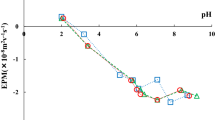Abstract
This work demonstrates that electrochemical reactions can be catalysed by the natural biofilms that form on electrode surfaces dipping into drinking water or compost. In drinking water, oxygen reduction was monitored with stainless steel ultra-microelectrodes under constant potential electrolysis at −0.30 V/SCE for 13 days. 16 independent experiments were conducted in drinking water, either pure or with the addition of acetate or dextrose. In most cases, the current increased and reached 1.5–9.5 times the initial current. The current increase was attributed to biofilm forming on the electrode in a similar way to that has been observed in seawater. Epifluorescence microscopy showed that the bacteria size and the biofilm morphology depended on the nutrients added, but no quantitative correlation between biofilm morphology and current was established. In compost, the oxidation process was investigated using a titanium based electrode under constant polarisation in the range 0.10–0.70 V/SCE. It was demonstrated that the indigenous micro-organisms were responsible for the current increase observed after a few days, up to 60 mA m−2. Adding 10 mm acetate to the compost amplified the current density to 145 mA m−2 at 0.50 V/SCE. The study suggests that many natural environments, other than marine sediments, waste waters and seawaters that have been predominantly investigated until now, may be able to produce electrochemically active biofilms.





Similar content being viewed by others
References
Costerton J.W., Lewandowski Z., Caldwell D.E., Korber D.R., Lappin-Scott H.M. (1995). Ann. Rev. Microbiol. 49:711
Mollica A. (1992). Int. Biodet. Biodegrad. 29:213
A. Mollica, E. Traverso and D. Thierry, in D. Thierry (Ed), Aspects of Microbially Induced Corrosion. (The Institute of Materials, London UK, 1997)
Beech I. (2004). Int. Biodeterior. Biodegrad. 53:177
H.C Flemming, in E. Heitz, H.C. Flemming and W. Sand (Eds), Microbially Induced Corrosion of Materials. (Springer-Verlag, Berlin Heidelberg, 1996), p. 5.
Block J.C., Haudidier K., Paquin J.L., Miazga J., Levi Y. (1993). Biofouling 6:333
Beech I., Sunner J. (2004). Curr. Op. Biotechnol. 15:181
I.B. Beech and C.C. Gaylarde, Revista de Microbiol. 30 (1999) 177, and ref. therein
Kim B.H., Kim H.J., Hyun M.S., Park D.H. (1999). J. Microbiol. Biotechnol. 9:127
Tender L.M., Reimers C.E., Stecher H.A. III, Holmes D.E., Bond D.R., Lowy D.A., Pinobello K., Fertig S.J., Lovley D.R. (2002). Nat. Biotechnol. 20:821
Kim B.H., Park H.S., Hyun M.S., Chang I.S., Kim M., Kim B.H. (2002). Enzyme Microbial Technol. 30:145
Lovley D.R., Stolz J.F., Nord G.L. Jr., Phillips E.J.P. (1987). Nature 330(6145):252
Lovley D.R., Giovannoni S.J., White D.C., Champine J.E., Phillips E.J.P., Gorby Y.A., Goodwin S. (1993). Arch. Microbiol. 159:336
Bond D.R., Lovley D.R. (2003). Appl. Environ. Microbiol. 69(3):1548
Bond D.R., Holmes D.E., Tender L.M., Lovley D.R. (2002). Science 295:483
Lin W.C., Coppi M.V., Lovley D.R. (2004). Appl. Environ. Microbiol. 70(4):2525
Pham C.A., Jung S.J., Phung N.T., Lee J., Chang I.S., Kim B.H., Yi H., Chun J. (2003). FEMS Microbiol. Lett. 223(1):129
Rabaey K., Verstraete W. (2005). Trends Biotechnol. 23:291
Gregory K.B., Bond D.R., Lovley D.R. (2004). Environ. Microbiol. 6:596
Lovley D.R. (2006). Curr. Opin. Biotechnol. 17:327
Kim B.H., Park H.S., Hyun M.S., Chang I.S., Kim M., Kim B.H. (2002). Enzyme Microbial Technol. 30:145
Chaudhuri S.K., Lovley D.R. (2003). Nature Biotechnol. 21:1229
Pham C.A., Jung S.J., Phung N.T., Lee J., Chang I.S., Kim B.H., Yi H., Chun J. (2003). FEMS Microbiol. Lett. 223(1):129
Bond D.R., Lovley D.R. (2005). Appl. Environ. Microbiol. 71(4):2186
Esteve-Núñez A., Rothermich M., Sharma M., Lovley D. (2005). Environ. Microbiol. 7(5):641
Lovley D.R. (2006). Nature Rev. Microbiol. 4:497
Reguera G., McCarthy K.D., Mehta T., Nicoll J.S., Tuominen M.T., Lovley D.R. (2005). Nature. 435(7045):1098
Lin W.C., Coppi M.V., Lovley D.R. (2004). Appl. Environ. Microbiol. 70(4):2525
Bergel A., Féron D., Mollica A. (2005). Electrochem. Commun. 7:900
Scotto V., Di Cintio R., Marcenaro G. (1985). Corr. Sci. 25:185
Scotto V., Lai M.E. (1998). Corr. Sci. 40:1007
D. Feѓon and I. Dupont, in S.A. Campbell, N. Campbell and F.C. Walsh (Eds), Developments in Marine Corrosion. (The Royal Society of Chemistry, Cambridge, 1998), p. 89.
Xinmin L., Gümpel P., Kässer M., Kreikenbohm R. (1998). Mater. Corrosion 49:897
Iverson A. (2001). Brit. Corrosion J. 36:277
Tender L.M., Reimers C.E., Stecher H.A., Holmes D.E., Bond D.R., Lowy D.A., Pilobello K., Fertig S.J., Lovley D.R. (2002). Nat. Biotechnol. 20(8):821
Gil G.C., Chang I.S., Kim B.H., Kim M., Jang J.K. (2003). Biosen. Bioelectron. 13:327
Amaya H., Miyuki H. (1995). Corr. Eng. 44:123
Le Bozec N., Compère C., L’Her M., Laouenan A., Costa D., Marcus P. (2001). Corr. Sci. 43:765
Scotto V., Lai M.E. (1998). Corr. Sci. 40:1007
Dupont I., Féron D., Novel G. (1998). Int. Biodet. Biodeg. 41:13
Lai M.E., Bergel A. (2000). J. Electroanal. Chem. 494:30
L’Hostis V., Dagbert C., Féron D. (2003). Electrochim. Acta 48:1451
Dickinson W.H., Caccavo F., Lewandowski Z. (1996). Corr. Sci. 38:1407
Mollica A., Cristiani P. (2003). Water Sci. Technol. 47:45
Acknowledgements
The authors acknowledge efficient help from Luc Etcheverry, engineer at CNRS, Laboratoire de Génie Chimique. They also thank Dr. Christophe Jacques for initiating the work on drinking water, and INPT technician Nourredine Chateur for his help in manufacturing the micro-sensors. The part of the work dealing with compost was supported by the European project “Electrochemically active biofilms (EA-Biofilms)”, 508866 NEST-Adventure 6th FP. The part devoted to drinking water was supported by the French Réseau d’Innovation Technologique RIT-Eau (project micro-CEB).
Author information
Authors and Affiliations
Corresponding author
Rights and permissions
About this article
Cite this article
Dulon, S., Parot, S., Delia, ML. et al. Electroactive biofilms: new means for electrochemistry. J Appl Electrochem 37, 173–179 (2007). https://doi.org/10.1007/s10800-006-9250-8
Received:
Accepted:
Published:
Issue Date:
DOI: https://doi.org/10.1007/s10800-006-9250-8




